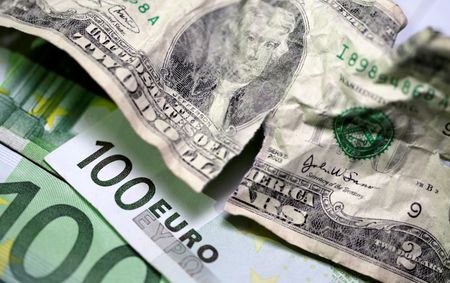
By Alun John
HONG KONG (Reuters) – The euro was heading for its best week since March 2020 and was testing a near three-month high after Thursday’s hawkish shift from the European Central Bank stoked speculation about the pace and timing of rate hikes.
Though the ECB kept rates on hold as widely expected, the euro climbed 0.26%, reaching as high as high as $1.468 in Asian trading on Friday in reaction to ECB president Christine Lagarde acknowledging the mounting inflation risks and declining to repeat previous guidance that an interest rate increase this year was extremely unlikely.
The European single currency was up 2.86% for the week, its best weekly gain since March 2020, during the early stages of the pandemic. A break above $1.1482, a level last seen on Jan.14, would be euro’s strongest since mid November.
“Lagarde opened the door for a new tightening cycle beginning by the ECB this year. The market has been pushing a bit towards that but the fact that the president has acknowledged this is a big deal,” said Rodrigo Catrill a senior FX strategist at National Bank of Australia.
The ECB had been seen as among the most dovish of the world’s leading central banks.
Sterling was at $1.361 having risen to a two-week top of $1.3626 on Thursday after BoE raised rates by 25 basis points and nearly half of its policymakers wanted a bigger increase to contain rampant inflation.
As a result the dollar index, measuring the greenback against six major peers, was at 95.169 having tumbled 2% this week – its biggest weekly fall since March 2020.
This is a sharp reversal after the index gained 1.65% a week earlier, when traders rejigged positions preparing for faster Federal Reserve rate hikes than had been previously expected. The markets are now factoring in five U.S. rate hikes this year.
U.S. non-farm payroll data is due later on Friday, but though it is expected to show a sharp slowdown in jobs growth due to the spread of the Omicron strain of COVID-19 in January, the data won’t be as crucial for the Fed as in the past, as the focus is more on inflation.
“We’ve been telling clients you’ve got to be ready for more volatility in FX markets and in markets in general when major central banks start entering a new pricing cycle, and that’s what we’ve seen in a dramatic way in the dollar in recent weeks,” Catrill added.
“Markets start wondering not only when (central banks) are going to hike but more importantly how quickly and how high they are going to go. It’s not just a Fed story now, its also a Bank of England, an ECB story and even an RBA story.”
The Reserve Bank of Australia governor, on Wednesday said a rate hike this year was possible, though argued there was a rare opportunity to reach full employment that justified being patient.
Friday’s RBA monetary policy statement did little to change that picture leaving the Aussie dollar at $0.7151.
The yen was at 114.88 per dollar, as the yield on benchmark 10- and five-year Japanese government bonds climbed to six-year highs in early Tokyo trading, with analysts starting to speculate that even the Bank of Japan might have to follow peers and tighten monetary policy.
(Reporting by Alun John; Editing by Edwina Gibbs & Simon Cameron-Moore)

